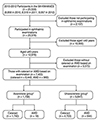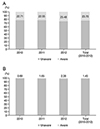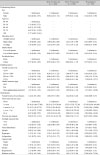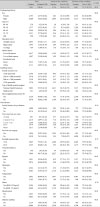1. Moody's Investors Service. Population aging will dampen economic growth over the next two decades [Internet]. Boston: Moody's Investors Service;2014. cited 2017 Aug 6. Available from:
https://www.moodys.com.
2. Li Y, Crews JE, Elam-Evans LD, et al. Visual impairment and health-related quality of life among elderly adults with age-related eye diseases. Qual Life Res. 2011; 20:845–852.
3. Bourne RR, Stevens GA, White RA, et al. Causes of vision loss worldwide, 1990-2010: a systematic analysis. Lancet Glob Health. 2013; 1:e339–e349.
4. Casten RJ, Rovner BW. Update on depression and age-related macular degeneration. Curr Opin Ophthalmol. 2013; 24:239–243.
5. Brody BL, Gamst AC, Williams RA, et al. Depression, visual acuity, comorbidity, and disability associated with agerelated macular degeneration. Ophthalmology. 2001; 108:1893–1900.
6. Bramley T, Peeples P, Walt JG, et al. Impact of vision loss on costs and outcomes in medicare beneficiaries with glaucoma. Arch Ophthalmol. 2008; 126:849–856.
7. Javitt JC, Zhou Z, Willke RJ. Association between vision loss and higher medical care costs in Medicare beneficiaries costs are greater for those with progressive vision loss. Ophthalmology. 2007; 114:238–245.
8. Marra KV, Wagley S, Kuperwaser MC, et al. Care of older adults: role of primary care physicians in the treatment of cataracts and macular degeneration. J Am Geriatr Soc. 2016; 64:369–377.
9. Bressler NM. Early detection and treatment of neovascular age-related macular degeneration. J Am Board Fam Pract. 2002; 15:142–152.
10. Huang OS, Zheng Y, Tay WT, et al. Lack of awareness of common eye conditions in the community. Ophthalmic Epidemiol. 2013; 20:52–60.
12. Yoo CU, Lee HJ, Yang YA. Common diseases in the elderly: data from Korea National Statistical Office. J Korean Assoc Occup Ther Policy Age Ind. 2013; 5:39–45.
13. Park HA. The Korea National Health and Nutrition Examination Survey as a primary data source. Korean J Fam Med. 2013; 34:79.
14. Kim Y, Park S, Kim NS, Lee BK. Inappropriate survey design analysis of the Korean National Health and Nutrition Examination Survey may produce biased results. J Prev Med Public Health. 2013; 46:96–104.
15. Kim EC, Cho E, Jee D. Association between blood cadmium level and age-related macular degeneration in a representative Korean population. Invest Ophthalmol Vis Sci. 2014; 55:5702–5710.
16. Bae JH, Shin DS, Lee SC, Hwang IC. Sodium intake and socioeconomic status as risk factors for development of age-related cataracts: the Korea National Health and Nutrition Examination Survey. PLoS One. 2015; 10:e0136218.
17. Kim TN, Lee JE, Lee EJ, et al. Prevalence of and factors associated with lens opacities in a Korean adult population with and without diabetes: the 2008-2009 Korea National Health and Nutrition Examination Survey. PLoS One. 2014; 9:e94189.
18. Lee DS, Han K, Kim HA, et al. The gender-dependent association between obesity and age-related cataracts in middle-aged Korean adults. PLoS One. 2015; 10:e0124262.
19. Yoon KC, Mun GH, Kim SD, et al. Prevalence of eye diseases in South Korea: data from the Korea National Health and Nutrition Examination Survey 2008-2009. Korean J Ophthalmol. 2011; 25:421–433.
20. Andersen RM, McCutcheon A, Aday LA, et al. Exploring dimensions of access to medical care. Health Serv Res. 1983; 18:49–74.
21. Zhang X, Andersen R, Saaddine JB, et al. Measuring access to eye care: a public health perspective. Ophthalmic Epidemiol. 2008; 15:418–425.
22. Varma R, Mohanty SA, Deneen J, et al. Burden and predictors of undetected eye disease in Mexican-Americans: the Los Angeles Latino Eye Study. Med Care. 2008; 46:497–506.
23. Suh HS, Kang HY, Kim J, Shin E. Effect of health insurance type on health care utilization in patients with hypertension: a national health insurance database study in Korea. BMC Health Serv Res. 2014; 14:570.
24. Neale RE, Purdie JL, Hirst LW, Green AC. Sun exposure as a risk factor for nuclear cataract. Epidemiology. 2003; 14:707–712.
25. Kim EC, Morgan IG, Kakizaki H, et al. Prevalence and risk factors for refractive errors: Korean National Health and Nutrition Examination Survey 2008-2011. PLoS One. 2013; 8:e80361.
26. Gibson DM. Diabetic retinopathy and age-related macular degeneration in the U.S. Am J Prev Med. 2012; 43:48–54.
27. Park SJ, Lee JH, Woo SJ, et al. Age-related macular degeneration: prevalence and risk factors from Korean National Health and Nutrition Examination Survey, 2008 through 2011. Ophthalmology. 2014; 121:1756–1765.
28. Dandona R, Dandona L, John RK, et al. Awareness of eye diseases in an urban population in southern India. Bull World Health Organ. 2001; 79:96–102.
29. de Jong PT. Age-related macular degeneration. N Engl J Med. 2006; 355:1474–1485.
30. Lee HS, Lee SS, Hwang IY, et al. Prevalence, awareness, treatment and control of hypertension in adults with diagnosed diabetes: the Fourth Korea National Health and Nutrition Examination Survey (KNHANES IV). J Hum Hypertens. 2013; 27:381–387.








 PDF
PDF ePub
ePub Citation
Citation Print
Print



 XML Download
XML Download